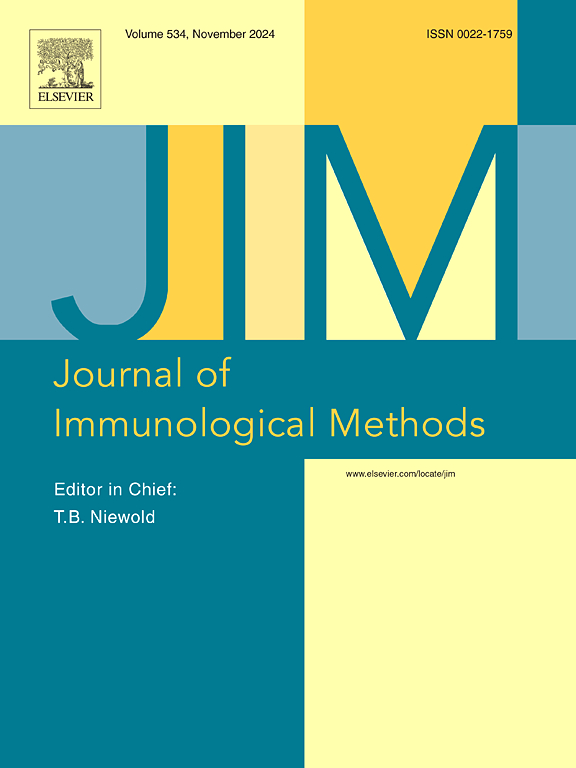Indirect ELISA diagnostic based on recombinant 3AB3 nonstructural protein of foot-and-mouth disease virus for use in porcine serology
IF 1.6
4区 医学
Q4 BIOCHEMICAL RESEARCH METHODS
引用次数: 0
Abstract
Foot-and-mouth disease (FMD), a disease of risk group 4 with transboundary importance, is a highly contagious devastating menace bearing serious concern that affects all susceptible cloven-hoofed animals eventuating striking economic losses to the livestock world. The elementary objective of this study was to optimize and validate the working parameters of an indirect ELISA based on prokaryotically expressed recombinant 3AB3 nonstructural protein (NSP) to estimate the 3AB3 NSP antibodies emanating from FMD virus (FMDV) infection and evaluate its performance highlighting the potential utility as a serological implement for surveillance of the disease in pig. Diversified categories of enzyme-linked immunosorbent assays (ELISAs) have been developed with wider use for evaluation of herd immunity in animals. However, recombinant antigen-based ELISAs are contemplated to be the preferred alternatives to tedious virus neutralization test, while antibody to 3AB3 NSP has been explored to be the most dependable and trust-worthy indicator for FMD. The 3AB3 NSP indirect ELISA, already in use in the country as a test for screening FMDV infection-specific antibodies in the bovine species was modified using anti-porcine IgG-horse radish peroxidase (HRP) conjugate and the test was successfully applied for pig. The assay performance was compared with an internationally accepted PrioCHECK® FMDV NS blocking ELISA kit. The overall diagnostic sensitivity (DSn) of the indirect ELISA was estimated to be 96.20 % (228/237), while the diagnostic specificity (DSp) on naïve and vaccinated animals varied at 96.63 % (316/327) and 96.94 % (286/295), respectively. In India, where FMD is prevalent and the pig population is high in some states, this ‘in-house’ optimized test system can be of immense utility paving the way for sero-epidemiological study in pigs, essentially critical for effective implementation of disease control strategies.
猪口蹄疫病毒重组3AB3非结构蛋白的间接ELISA诊断
口蹄疫是具有跨界重要性的第4类风险疾病,是一种高度传染性的破坏性威胁,令人严重关切,影响到所有易感的偶蹄动物,给畜牧业造成巨大的经济损失。本研究的主要目的是优化和验证基于原核表达重组3AB3非结构蛋白(NSP)的间接ELISA的工作参数,以估计口蹄疫病毒(FMDV)感染产生的3AB3 NSP抗体,并评估其性能,突出其作为猪疾病监测血清学工具的潜在用途。多种类型的酶联免疫吸附测定法(elisa)已被广泛用于动物群体免疫的评估。然而,基于重组抗原的elisa被认为是繁琐的病毒中和试验的首选替代方案,而3AB3 NSP抗体已被探索为口蹄疫最可靠和值得信赖的指标。采用抗猪igg -马萝卜过氧化物酶(HRP)偶联物修饰的3AB3 NSP间接ELISA法已在国内用于牛口蹄疫感染特异性抗体的筛选,并成功应用于猪。与国际通用的PrioCHECK®FMDV NS阻断ELISA试剂盒进行比较。间接ELISA的总体诊断敏感性(DSn)估计为96.20 %(228/237),而对naïve和接种动物的诊断特异性(DSp)分别为96.63 %(316/327)和96.94 %(286/295)。在口蹄疫流行的印度,一些州的猪群数量很高,这种“内部”优化的测试系统可以为猪的血清流行病学研究铺平道路,对有效实施疾病控制战略至关重要。
本文章由计算机程序翻译,如有差异,请以英文原文为准。
求助全文
约1分钟内获得全文
求助全文
来源期刊
CiteScore
4.10
自引率
0.00%
发文量
120
审稿时长
3 months
期刊介绍:
The Journal of Immunological Methods is devoted to covering techniques for: (1) Quantitating and detecting antibodies and/or antigens. (2) Purifying immunoglobulins, lymphokines and other molecules of the immune system. (3) Isolating antigens and other substances important in immunological processes. (4) Labelling antigens and antibodies. (5) Localizing antigens and/or antibodies in tissues and cells. (6) Detecting, and fractionating immunocompetent cells. (7) Assaying for cellular immunity. (8) Documenting cell-cell interactions. (9) Initiating immunity and unresponsiveness. (10) Transplanting tissues. (11) Studying items closely related to immunity such as complement, reticuloendothelial system and others. (12) Molecular techniques for studying immune cells and their receptors. (13) Imaging of the immune system. (14) Methods for production or their fragments in eukaryotic and prokaryotic cells.
In addition the journal will publish articles on novel methods for analysing the organization, structure and expression of genes for immunologically important molecules such as immunoglobulins, T cell receptors and accessory molecules involved in antigen recognition, processing and presentation. Submitted full length manuscripts should describe new methods of broad applicability to immunology and not simply the application of an established method to a particular substance - although papers describing such applications may be considered for publication as a short Technical Note. Review articles will also be published by the Journal of Immunological Methods. In general these manuscripts are by solicitation however anyone interested in submitting a review can contact the Reviews Editor and provide an outline of the proposed review.

 求助内容:
求助内容: 应助结果提醒方式:
应助结果提醒方式:


